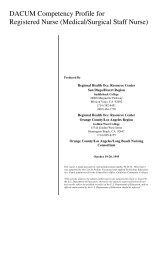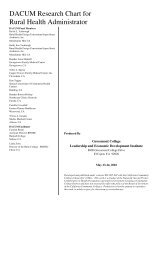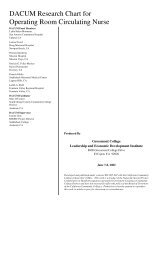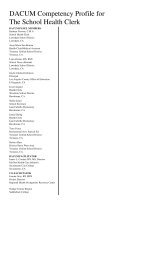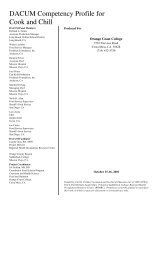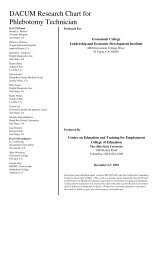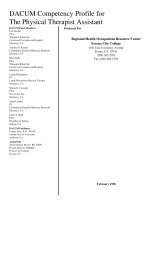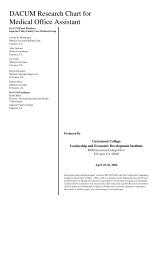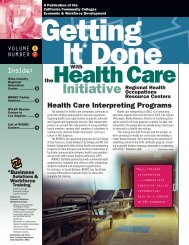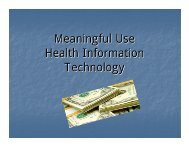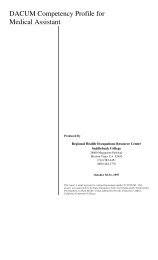Nursing Considerations & the Future of Telehealth Chapter 5 - CA-HWI
Nursing Considerations & the Future of Telehealth Chapter 5 - CA-HWI
Nursing Considerations & the Future of Telehealth Chapter 5 - CA-HWI
Create successful ePaper yourself
Turn your PDF publications into a flip-book with our unique Google optimized e-Paper software.
<strong>Nursing</strong> <strong>Considerations</strong> & <strong>the</strong><br />
<strong>Future</strong> <strong>of</strong> <strong>Telehealth</strong><br />
<strong>Chapter</strong> 5<br />
WRITTEN BY:<br />
VALERIE FISHER, RN, MA<br />
HEALTH WORKFORCE INITIATIVE<br />
2 013<br />
D i s c l a i m e r : T h i s p u b l i c a t i o n w a s s u p p o r t e d b y S u b r e c i p i e n t a g r e e m e n t w i t h t h e B u t t e - G l e n n<br />
C o m m u n i t y C o l l e g e D i s t r i c t u n d e r P r i m e A g r e e m e n t n u m b e r H 1 1 - 0 5 2 4 V f r o m t h e S p o n s o r . A n y<br />
o p i n i o n s , f i n d i n g s , a n d c o n c l u s i o n s o r r e c o m m e n d a t i o n s e x p r e s s e d i n t h i s p u b l i c a t i o n a r e t h o s e o f<br />
t h e a u t h o r ( s ) a n d d o n o t n e c e s s a r i l y r e f l e c t t h e v i e w s o f t h e B u t t e - G l e n n C o m m u n i t y C o l l e g e<br />
D i s t r i c t o r t h o s e o f t h e S p o n s o r .
Statement <strong>of</strong> Purpose<br />
• The purpose <strong>of</strong> this module is to explore newer applications <strong>of</strong><br />
broadband adoption <strong>of</strong> telehealth technologies in hospitals (both<br />
inpatient ICUs and post acute care) with specific emphasis on<br />
telehealth nursing or its implications in nursing practice.<br />
• We will also examine <strong>the</strong> benefits, barriers and successes <strong>of</strong><br />
telehealth in outpatient chronic disease management while<br />
considering how futuristic telehealth models may be an answer to<br />
projected physician shortages in <strong>the</strong> future.
Objectives<br />
Upon completion <strong>of</strong> this chapter, <strong>the</strong> nurse will be able to :<br />
1. Define telehealth nursing and its role in delivering patient care.<br />
2. List <strong>the</strong> areas <strong>of</strong> <strong>the</strong> hospital in which telehealth technology is advancing<br />
and how it can facilitate improved patient care.<br />
3. Describe <strong>the</strong> functions <strong>of</strong> a tele-ICU and how it is different from a<br />
traditional hospital ICUs.<br />
4. List at least 3 nursing competencies needed to be a successful tele-ICU<br />
nurse.<br />
5. Give one example <strong>of</strong> a tele-ICU or e-ICU nursing intervention.<br />
6. Discuss chronic disease in America and <strong>the</strong> use <strong>of</strong> telemonitoring.<br />
7. List at least 3 elements needed for a successful telemedicine system .
Terminology<br />
• Telemedicine or <strong>Telehealth</strong> is comprised <strong>of</strong> <strong>the</strong> use <strong>of</strong> medical and o<strong>the</strong>r<br />
health information exchanged via electronic communications from one site to<br />
ano<strong>the</strong>r with <strong>the</strong> intent <strong>of</strong> improving <strong>the</strong> health status <strong>of</strong> consumers (ATA, 2007).<br />
• <strong>Telehealth</strong> nursing is <strong>the</strong> delivery, management, and coordination <strong>of</strong> care and<br />
services provided via telecommunications technology within <strong>the</strong> domain <strong>of</strong><br />
nursing. (American Association <strong>of</strong> Critical Care Nurses -AACN, 2004)<br />
• Tele-ICUs are networks <strong>of</strong> audiovisual communications and computer system<br />
that link critical care physicians (intensivists) and nurses to intensive care units<br />
(ICUs) in o<strong>the</strong>r remote hospitals. (AACN)<br />
• Tele-ICU <strong>Nursing</strong> as defined by AACN, is a highly skilled critical care nurse who<br />
continuously monitors data on large populations <strong>of</strong> patients and acts as real-time<br />
clinical decision support to collaborate with <strong>the</strong> bedside nurses on conditions that<br />
require immediate attention.<br />
• Cloud Technology - A model for delivering information technology services in<br />
which resources are retrieved from <strong>the</strong> internet through web-based tools and<br />
applications, ra<strong>the</strong>r than a direct connection to a server. “Cloud” structure allows<br />
access to information as long as an electronic device has access to <strong>the</strong> web.
Why Broadband and Telemedicine?<br />
• Improve access to all communities encouraging frequent, and meaningful<br />
interactions with a health care team in collaboration which leads to<br />
improved patient outcomes.<br />
• Patients gain improved access to care while decreasing or reducing <strong>the</strong><br />
need to travel distances to see a specialist or subspecialist.<br />
• In <strong>the</strong> case <strong>of</strong> an emergency (head injury or stroke patient), transportation<br />
cost via air/ground ambulance to a level IV trauma center can be diverted<br />
if emergency specialist can be accessed via telehealth technology and<br />
appropriate care can be given at <strong>the</strong> current facility.<br />
• Patients with chronic conditions (diabetes, HTN, CHF, <strong>CA</strong>D) will have <strong>the</strong><br />
opportunity to be closely monitored, and with early intervention<br />
admissions to <strong>the</strong> hospital can be averted.
Diagnosis & Therapy Changes<br />
with <strong>Telehealth</strong> Consultations<br />
Marcin JP, ,Nesbitt TS, Cole SL, ,Knuttel RM, Hilty DM, Prescott PT, Daschbach MM. Changes in diagnosis,<br />
treatment, and clinical improvement among patients receiving telemedicine consultations. Telemed JE<br />
Health.2005Feb;11(1):36-43
Utilization <strong>of</strong> <strong>Telehealth</strong> & <strong>Nursing</strong> Practice<br />
“<strong>Telehealth</strong> nurses need <strong>the</strong> same nursing skills as all nurses practicing in<br />
specialty areas, but with an ability to utilize <strong>the</strong> technology to <strong>the</strong> best <strong>of</strong><br />
its ability to assess and communicate <strong>the</strong> patient’s physical and mental<br />
status,” Leenknecht said. “Excellent organization, critical thinking and<br />
communication skills are required also, but <strong>the</strong> most important skill is to<br />
understand <strong>the</strong> technology and its potential and limitations and have <strong>the</strong><br />
intuitiveness in how to utilize it to provide <strong>the</strong> care needed at <strong>the</strong> time.”<br />
Cindy K. Leenknecht, MS, ACNS-BC, chair <strong>of</strong> <strong>the</strong> ATA <strong>Telehealth</strong><br />
<strong>Nursing</strong> Special Interest Group (SIG)<br />
Nursezone.com, Devices & Technology,<br />
Telemedicine: Virtual Patient Care and Collaboration, June 13, 2012.
<strong>Telehealth</strong> <strong>Nursing</strong><br />
The benefits <strong>of</strong> telehealth for both <strong>the</strong> patient and <strong>the</strong> healthcare provider is well<br />
documented. But how do <strong>the</strong>se new technologies impact direct patient care, and your<br />
nursing practice? In many ways it doesn’t because:<br />
• In all areas <strong>of</strong> telehealth nursing, including all related roles and functions,<br />
telehealth nurses are committed to leveraging technology and nursing expertise to<br />
provide quality nursing care, to delivering nursing expertise to those who need<br />
care, to improving health and patients’ outcomes.<br />
• <strong>the</strong> body <strong>of</strong> nursing knowledge and competencies remain constant; it is merely <strong>the</strong><br />
medium <strong>of</strong> delivery that is different from traditional nursing care.<br />
• <strong>the</strong> nurse remains <strong>the</strong> conduit between <strong>the</strong> patient and <strong>the</strong> remote practitioner by<br />
assisting in <strong>the</strong> “presentation” <strong>of</strong> <strong>the</strong> patient, <strong>the</strong>ir complaints, symptoms and<br />
clinical data.<br />
• telehealth nurses adhere to <strong>the</strong> same standards <strong>of</strong> quality, patient privacy, and<br />
confidentiality as established in traditional nursing practice & as governed by law.<br />
(American Telemedicine Association: <strong>Telehealth</strong> <strong>Nursing</strong>, April 2008)
Innovative Use <strong>of</strong> <strong>Telehealth</strong><br />
in <strong>the</strong> Inpatient Settings*<br />
Many departments within a hospital can utilize telehealth functionality, and some<br />
now rely on it exclusively to increase <strong>the</strong> hospital’s spectrum <strong>of</strong> care, especially for<br />
facilities with limited resources.<br />
Telemedicine: The Road to Improved Rural Health Care?<br />
(Click on link, 5:58)<br />
Some o<strong>the</strong>r Examples:<br />
• Tele-ICU – For advanced patient monitoring <strong>of</strong> ICU patients by distant<br />
staff/MD Intensivist via cameras, microphones, and monitoring <strong>of</strong> vital signs<br />
via specialty devices.<br />
Avera Health Video on eICU Program * (Click on link, 5:28)<br />
• Neurology/Telestroke - Neurologists are available to provide collaborative care<br />
recommendations to emergency physicians on patients with acute stroke,<br />
transient ischemic attack (TIA), and stroke-like conditions.<br />
UC San Diego Telemedicine for Stroke (Click on link, 4:50)<br />
(Note how <strong>the</strong> ER nurse facilitates <strong>the</strong> physical exam for <strong>the</strong> telemedicine MD)
Continued <strong>Telehealth</strong> Inpatient Use*<br />
• Telepathology –When a pathologist is not available or on staff,<br />
technology can facilitate <strong>the</strong> transfer <strong>of</strong> image-rich pathology data for a<br />
real-time diagnosis.<br />
Arizona Telemedicine Program (Click on link, 5:32)<br />
• Teleradiology – Yes, you guessed it! Sharing <strong>of</strong> high definition images<br />
over broadband for evaluation and consultation <strong>of</strong> patients in remote<br />
areas with regional radiologist located at larger teaching facilities or via<br />
private radiological consultation companies.<br />
• Psychological/Mental Health Services – for remote psych evaluations<br />
Cloud Visit Psychiatry for HIPAA-Compliant Telemedicine<br />
(Click on link, 0:51)<br />
* Vendor technology is being shared to illustrate this field and is not an endorsement <strong>of</strong> <strong>the</strong> product or vendor.
Definition <strong>of</strong> a Tele-ICU<br />
“A tele-ICU uses state-<strong>of</strong>-<strong>the</strong>-art equipment to connect patients to nurses (sic) intensivists 24<br />
hours a day, seven days a week, from anywhere in <strong>the</strong> country – or <strong>the</strong> world. These doctors<br />
and nurses, at a centralized location, use remote-control cameras, video conferencing and<br />
continuous monitoring technology to access real-time patient information – including vital<br />
signs, physiologic data, medications and lab results. The intensivists and nurses also have<br />
access to patients’ complete medical history and local attending physicians’ care plans and can<br />
talk to patients directly. This technical leverage allows a qualified medical team to care for<br />
large numbers <strong>of</strong> patients and meaningful impacts <strong>the</strong> labor shortage.”<br />
Mary Jo Gorman, M.D., MBA, CEO <strong>of</strong> Advanced ICU Care*<br />
The <strong>Future</strong> <strong>of</strong> Tele-ICUs: An Insiders Perspective,<br />
Med GADGET. Web. June 30, 2011<br />
How an eICU Program Works (Click on link, 1:58)<br />
* Please note: Vendor technology is being shared to illustrate this field and is not an endorsement <strong>of</strong> <strong>the</strong> producto or vendor.
Telemedicine ICU<br />
Telemedicine ICUs use a host <strong>of</strong> different technologies to monitor <strong>the</strong> sickest<br />
patients; improving patient outcomes and decreasing hospital stays and cost.
AACN’s Statement on Tele-ICU <strong>Nursing</strong><br />
“Because tele-ICU nursing is a subspecialty still in its early days, solid<br />
research evidence on <strong>the</strong> practice does not yet exist…….The rapidly changing<br />
and diverse nature <strong>of</strong> tele-ICU nursing practice requires nurses to be nimble<br />
and collaboratively create <strong>the</strong> best environments and models for advancing<br />
<strong>the</strong> practice…....There is no doubt that tele-health services will continue to<br />
expand beyond what can even be imagined today. Research focused on best<br />
practice models and operational interventions must be ongoing and<br />
disseminated widely to enhance <strong>the</strong> level <strong>of</strong> practice and patient outcomes as<br />
tele-ICU nursing practice evolves.”<br />
AACN Tele-ICU <strong>Nursing</strong> Practice Guidelines<br />
American Association <strong>of</strong> Critical Care Nurses<br />
March 2013
AACN’s Tele-ICU <strong>Nursing</strong> Practice Guidelines<br />
1. Tele-ICU leaders and nurses must establish and sustain an environment<br />
that promotes effective communication, collaboration, and collegiality<br />
to ensure optimal quality outcomes.<br />
2. Tele-ICU nurses must demonstrate pr<strong>of</strong>iciency in specific knowledge,<br />
skills, and competencies to contribute maximally to patient outcomes<br />
and nursing practice.<br />
3. Tele-ICU leaders and nurses must be actively engaged in measuring and<br />
analyzing outcomes to ensure ongoing improvement in patient care and<br />
tele-ICU nurses’ contribution to care.<br />
To download a free full PDF text <strong>of</strong> this document,<br />
Click here: AACNs website
AACN’s Tele-ICU Model <strong>of</strong> Success
Tele-ICU Nurse Competencies<br />
CriticalCareNurse Vol 31, No. 5, OCTOBER 2011, Tele-ICU Unit Competencies by Susan Goran, RN, MSN
Examples <strong>of</strong> e-ICU <strong>Nursing</strong> Interventions<br />
Example #1 – Clinical Judgment<br />
During virtual rounds, <strong>the</strong> tele-ICU nurse notes that <strong>the</strong> patient is experiencing a new onset <strong>of</strong><br />
bradycardia with a 16-point reduction in systolic blood pressure. The nurse reviews <strong>the</strong> patient’s<br />
pertinent data including <strong>the</strong> medical history, trends in vital signs, laboratory values, and any<br />
change in medications in <strong>the</strong> past 6 hours. Upon review <strong>of</strong> <strong>the</strong> nursing documentation, it is<br />
noted that <strong>the</strong> patient was given an unusually large dose <strong>of</strong> dexmedetomidine to achieve effect.<br />
The tele-ICU nurse is aware that <strong>the</strong> nurses in this ICU have limited experience with <strong>the</strong> use and<br />
titration <strong>of</strong> this medication and phones <strong>the</strong> bedside nurse to <strong>of</strong>fer assistance. Toge<strong>the</strong>r <strong>the</strong>y<br />
review <strong>the</strong> side effects and titration <strong>of</strong> <strong>the</strong> medication, and <strong>the</strong> decision is made to decrease <strong>the</strong><br />
dose. Within 2 hours, <strong>the</strong> patient’s bradycardia has resolved with a return to baseline blood<br />
pressure.<br />
Example #2 – Systems Thinking<br />
A 42-year-old woman in a community hospital has a cardiac arrest; <strong>the</strong> tele-ICU nurse (teleintensivist<br />
not on duty) assists with <strong>the</strong> resuscitation efforts, which are successful. However,<br />
when <strong>the</strong> tele-ICU nurse raises <strong>the</strong> question <strong>of</strong> post resuscitation hypo<strong>the</strong>rmia, <strong>the</strong> bedside team<br />
appears unaware <strong>of</strong> this option. At <strong>the</strong> request <strong>of</strong> <strong>the</strong> ICU, <strong>the</strong> tele-ICU nurse notifies <strong>the</strong> onduty<br />
intensivist at <strong>the</strong> tertiary care facility and arranges a transfer for <strong>the</strong> patient.<br />
CriticalCareNurse Vol 31, No. 5, OCTOBER 2011, Tele-ICU Unit Competencies by Susan Goran, RN, MSN
Remote Monitoring in e-ICUs, a New Study<br />
A recent study published in JAMA, <strong>the</strong> University <strong>of</strong> Massachusetts<br />
Memorial Medical Center compared over 6000 pre/post Tele-ICU<br />
monitoring patients with very positive results. According to <strong>the</strong> article:<br />
• ICU hospital acquired infections decreased by over 12%.<br />
• Mortality rates dropped by 2% in e-ICU patients compared to non-remote<br />
monitored patients.<br />
• Length <strong>of</strong> stay decreased by 4.5 days for patients with interventional<br />
monitoring.<br />
Journal <strong>of</strong> <strong>the</strong> American Medical Association.<br />
2011 Oct 5;306(13):1441; Metske, HA. Spronk PE, Schultz MJ,<br />
Tele-ICU Reengineering <strong>of</strong> Critical Care Processes
Telemonitoring in a Post Discharge Setting<br />
• Often even with <strong>the</strong> most optimal care during hospitalization,<br />
complications can occur post discharge and/or <strong>the</strong> patient still requires<br />
close monitoring for <strong>the</strong>ir condition once discharged.<br />
• In <strong>the</strong>se circumstances, home monitoring is utilized and can greatly assist<br />
with <strong>the</strong> recognition <strong>of</strong> problems before <strong>the</strong>y become major complications<br />
hopefully eliminating <strong>the</strong> need for additional hospitalization.<br />
• One example <strong>of</strong> this scenario is a heart patient with a post operative<br />
cardiovascular implantable electronic devices or CIEDs. (Pacemaker or<br />
Implantable Cardioverter Defibrillator)<br />
Remote Cardiac Monitoring System (Click on link, 3:56)
How can remote or wireless monitoring help a patient with<br />
a cardiac pacemaker or internal defibrillator?<br />
• It is imperative that Cardiac Pacemakers and Intra Coronary defibrillators<br />
(hereby identified as cardiovascular implantable electronic devices or<br />
CIEDs) be assessed frequently to assess battery life and to ensure <strong>the</strong><br />
device is working correctly and delivering <strong>the</strong> appropriate <strong>the</strong>rapy.<br />
• Until quite recently CIEDs required <strong>the</strong> patient to physically visit <strong>the</strong><br />
cardiac clinic for a device interrogation and evaluation every 6 months.<br />
• With <strong>the</strong> advent <strong>of</strong> remote home monitoring it has become possible to<br />
interrogate <strong>the</strong> CIED from <strong>the</strong> patient’s home thus providing increased<br />
frequency <strong>of</strong> monitoring while ensuring effective and timely interventions.<br />
Both remote and wireless technology now is available.<br />
Long-Term Home Monitoring <strong>of</strong> Cardiac Patients with IMEC’s Patch<br />
(Click on link, 2:11)<br />
Patient Adherence in Remote Follow-up <strong>of</strong> Cardiovascular Implantable Electronic Devices.<br />
Ren, Xiushui, et al. Journal <strong>of</strong> <strong>the</strong> American College <strong>of</strong> Cardiology 59.13s1 (2012) E645.
Case Study – Home Telemonitoring for CHF<br />
Aim <strong>of</strong> <strong>the</strong><br />
study<br />
• A literature review comparing home<br />
Telemonitoring with usual care.<br />
• 21 original studies on home telemonitoring for pts<br />
with CHF were included ( 3082 pts)<br />
Results<br />
• Patient quality <strong>of</strong> life was measured as similar or<br />
better than with usual care<br />
• Patient satisfaction was measured as similar or<br />
better than with usual care.<br />
J Telemed Telecare. 2010; 16 (2) : 68-76. E pub 2009 Dec 11. Home Telemonitoring for congestive heart failure a systemic<br />
review and meta analysis. Polisena J, Tran K, Cimon K, Hutton B, Mc Gill S, Palmer K, Scott RE. Canadian agency for drugs<br />
and technologies in health, Ottawa, Ontario, Canada.
Chronic Disease in America<br />
• In 2010, <strong>the</strong> most common chronic conditions among Medicare beneficiaries were:<br />
1. High blood pressure (58%), 2. High cholesterol (45%), 3. Heart disease<br />
(31%), 4. Arthritis (29%) and 5. Diabetes (28%.)<br />
• 14% <strong>of</strong> Medicare beneficiaries have 6 or more chronic conditions (percent <strong>of</strong><br />
chronic disease increases with age).<br />
• In 2010, about one in five Medicare beneficiaries were admitted to a hospital (cost<br />
<strong>of</strong> over $100 billion). However, among <strong>the</strong> 14% <strong>of</strong> beneficiaries with 6 or more<br />
chronic conditions, over 60% were hospitalized, (accounting for 55% <strong>of</strong> total<br />
Medicare hospitalizations cost).<br />
• Beneficiaries with 6 or more chronic conditions accounted for 63% <strong>of</strong> post<br />
hospitalization costs ($54.7 Billion).<br />
• Medicare spending for 2010 was over 300 billion dollars!<br />
Centers for Medicare & Medicaid Services. Chronic Conditions Among Medicare Beneficiaries, Chartbook, 2012.
Use <strong>of</strong> <strong>Telehealth</strong> in Chronic<br />
Disease Management<br />
• Use <strong>of</strong> telehealth technologies gives us <strong>the</strong> opportunity to reduce Medicare<br />
cost by not only remodeling how we provide care, but by also facilitating<br />
early and direct intervention for patients with multiple chronic disease<br />
conditions.<br />
• The US Department <strong>of</strong> Veterans Affairs leads industry in telehealth<br />
programs that reduce over all health care cost. (Estimated at $2K/yr./pt)<br />
• In 2010, over 43,000 veterans were enrolled in home telehealth care for<br />
chronic diseases. Ano<strong>the</strong>r 49,000 patients in rural areas go to VA clinics to<br />
consult with physicians and specialists via telehealth videoconferencing<br />
services. (The Business <strong>of</strong> Federal Technology – May 2010)<br />
• In 2008 a study by <strong>the</strong> VA showed a reduction <strong>of</strong> rural veterans hospital<br />
admissions by 50% with <strong>the</strong> use <strong>of</strong> telemedicine.(Source as above)<br />
<strong>Telehealth</strong> - DeptVetAffairs<br />
(Click on link, 2:36)
As a Nurse, How do you feel about<br />
telehealth technologies in your workplace?<br />
• Will telehealth technology diminish <strong>the</strong> quality <strong>of</strong> nursing care due to an<br />
absence <strong>of</strong> direct hands-on assessments or face-to-face interactions? Or<br />
will it enhance care especially for seniors who are isolated at home?<br />
• How comfortable are you working with technology? Are you a digital<br />
native or a baby boomer who sometimes needs more time to catch on?<br />
What is your ability to troubleshoot should <strong>the</strong> technology fail? Do you<br />
have a back up plan in place for <strong>the</strong> patient if it does?<br />
• As an experienced ICU nurse not accustom to working with a remote ICU<br />
monitoring system, does <strong>the</strong> ability to access immediate consultation on<br />
your patient’s status give you a feeling <strong>of</strong> extra security or kind <strong>of</strong> make<br />
you nervous that someone is watching you and your patient?
More Questions for <strong>the</strong> Nurse to Contemplate<br />
• Will use <strong>of</strong> technology in <strong>the</strong> clinical setting provide an additional<br />
opportunity for patient education and communication? Or do you feel it<br />
might get in <strong>the</strong> way <strong>of</strong> required health education and teaching?<br />
• Do you feel that <strong>the</strong> patients health information is more or less secure<br />
using EHR with broadband technologies?<br />
Remember……..<br />
No matter which technology you are using in <strong>the</strong> clinical setting it remains<br />
just a technological tool; a means <strong>of</strong> transferring information to a remote<br />
location to o<strong>the</strong>rs for evaluation or consultation.<br />
The primary patient care role <strong>of</strong> <strong>the</strong> nurse does not change,<br />
it remains based in nursing expertise<br />
and evidence based practices.
Benefits <strong>of</strong> <strong>Telehealth</strong> for Nurses<br />
• If remote monitoring, you can “see” patient and catch possible problems<br />
early and <strong>of</strong>fer effective interventions.<br />
• If facilitating home care monitoring, you will spend less time traveling<br />
between patients, thus using time more efficiently and increasing time<br />
with patients and <strong>the</strong>ir families.<br />
• Increased patient satisfaction <strong>of</strong> <strong>the</strong>ir care assist with self-empowerment<br />
and facilitates active participation in recovery or disease management.<br />
• Improvement in communication by sharing patient data increases team<br />
collaborative practices while improving patient care.<br />
• Continuously working with new technology guarantees life-long learning.<br />
• It just might be fun to work with new technologies!
Necessary Elements for Successful Telemedicine<br />
• Reliable broadband connectivity (both wired & wireless)<br />
• Distribution <strong>of</strong> equipment – Broadband access is still lacking in many<br />
areas <strong>of</strong> <strong>the</strong> US.<br />
• Standardization with interoperability – Hardware, s<strong>of</strong>tware, peripheral<br />
devices, protocols – everything needs to “talk” to everything else.<br />
• New regulatory policies that support Telemedicine - reimbursement,<br />
credentialing, interstate/national licensing.<br />
• Advances in technology to gain even wider uses - mobile apps,<br />
bluetooth and use <strong>of</strong> <strong>the</strong> “Cloud”.<br />
• Trained workforce to utilize all <strong>of</strong> <strong>the</strong>se technologies<br />
As a nation, we still have a long way to go before telemedicine is woven<br />
into everyday medicine, but we are on our way with at least 50% <strong>of</strong> large<br />
teaching hospitals already wired and using technology regularly.
Some Potential Barriers <strong>of</strong> Telemedicine<br />
• Facilitating any change can be complex, confusing and time consuming.<br />
Specific barriers need to be identified early in <strong>the</strong> change management<br />
process and a reasonable time-line part <strong>of</strong> <strong>the</strong> implementation process.<br />
• Educating providers, patients, families and communities will require<br />
additional resources, education and support over a considerable timeframe.<br />
• Broadband access needs to be readily available and straightforward to use.<br />
All technology interfaces need to be adaptable, easily updated and<br />
compatible with o<strong>the</strong>r systems.<br />
• Cost <strong>of</strong> equipment and s<strong>of</strong>tware for telehealth solutions can be costly<br />
upfront investment even with government support.
New Ways to Address Physician Shortages?<br />
While <strong>the</strong>re are still many barriers to overcome with <strong>the</strong> use <strong>of</strong> telemedicine<br />
in <strong>the</strong> United States; one area which it may prove to be invaluable is in<br />
helping to ease <strong>the</strong> crisis <strong>of</strong> <strong>the</strong> anticipated physician shortage.<br />
More specifically, physicians are needed in rural areas where 25% <strong>of</strong><br />
Americans live but only 9% <strong>of</strong> physicians practice. And it is predicted that by<br />
2025, <strong>the</strong> nation will be short over 52,000 physicians! Now, with new<br />
advances in telehealth robotic technology physicians can be brought to <strong>the</strong><br />
patient via mobile robots.<br />
Robotics Advance Practice <strong>of</strong> Tele-medicine (Click on link, 1:32)<br />
Mercy <strong>Telehealth</strong> Network (Click on link, 3:01)<br />
Yale Journal <strong>of</strong> Medicine and Law, Vol.IX, Issue 1, February 16, 2013.
Conclusion<br />
• Evidence based literature shows that <strong>the</strong> future <strong>of</strong> health care is rapidly evolving to<br />
include many hospital-based technologies and home care via telemedicine.<br />
• Both public and private healthcare providers need to continue substantial<br />
investment to assure <strong>the</strong> existence <strong>of</strong> technology-enabled health care that is both<br />
seamless and efficient.<br />
• Advanced technology in health care has already provided for new career<br />
opportunities for nurse; but many more diverse roles will evolve as nursing<br />
expertise continues to be pivotal in <strong>the</strong> implementation <strong>of</strong> new technology and<br />
improvements in patient care.<br />
• Although <strong>the</strong> impetus for change in <strong>the</strong> health care paradigm is largely a result <strong>of</strong><br />
economic constraints, <strong>the</strong> benefits to patients and healthcare providers are vast. As<br />
this shift moves us into <strong>the</strong> future, we can be assured <strong>the</strong>re will be more and even<br />
better technological advances that will expand <strong>the</strong> future <strong>of</strong> healthcare for all <strong>of</strong> us.



